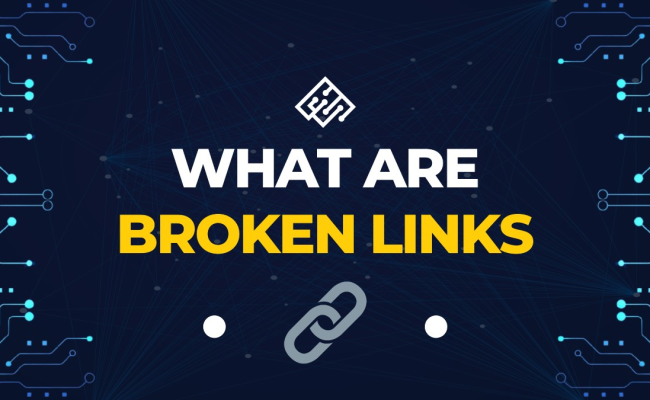Understanding broken links is crucial for all internet users in the digital age, not just administrators. Continue reading the article to understand what broken links are, their causes, consequences, and solutions.
Broken links impede internet information flow, frustrate users, and challenge webmasters’ efforts for a positive experience. Understanding them is vital for all internet users. This investigation explores broken links’ causes, effects, and the importance of maintaining internet transparency and usability.
What Are Broken Links? How To Find And Fix Broken Links?
What is an example of a broken link?
What is the difference between lost and broken links?
What are broken links on a website?
What is a broken link in HTML?
What are broken photo links in blogs?
What happens if broken Favicon links are deleted?
What does it mean when links are broken on Instagram?
What are the disadvantages of broken links?
What are broken links in SEO?
Broken links, called dead links or link rot, don’t work or point to valid destinations. A “404 Not Found” error appears when you click, showing the page or resource is missing.
Links may break for several reasons, including the following:
- The linked page was removed or deleted: Any links that link to a webpage taken down or deleted by the website owner will stop working.
- URL change: A link will break if someone changes the URL (web address) of the linked page without updating the link.
- Server problems: Links may occasionally break due to technical issues or outages experienced by web servers.
- Content reorganization: Links leading to the wrong destination may emerge from structural or organizational website changes.
- Typos or errors: Simple errors, such as typos in the HTML code or hyperlink, might result in broken links.
- External websites: If those websites modify or remove the connected content, links to external websites may stop working.
Broken links can annoy website users since they interfere with their surfing experience and diminish their reputation.
What is an example of a broken link?
Here is an example of a broken link:
Say you have a blog post with a link intended to go to a particular external website.
If the website owner changes their home page address without notifying you, it can break the link. Therefore, if their homepage’s new URL is:
The changed URL makes the original link invalid, causing a “404 Not Found” error when clicked. This is a typical illustration of a broken link when the linked website changes, making the intended destination unreachable.
What is the difference between lost and broken links?
Here’s a table outlining the key differences between lost and broken links:
| Aspect | Lost Links | Broken Links |
| Definition | Links that were once active but are no longer accessible or have been removed. | Links that lead to web pages that no longer exist or return a 404 error (Page Not Found). |
| Accessibility | Lost links can still exist on a webpage but may point to the wrong or non-existent URL. | Broken links typically result in an error message when clicked, indicating that the intended webpage is unavailable. |
| Causes |
|
|
| Impact on SEO | Lost links may still pass some link juice to the target page if they exist on a high-quality website. | Broken links can negatively impact SEO, creating a poor user experience and signaling outdated or poorly maintained content. |
| User experience | Users may not be aware that a lost link is no longer valid unless they click on it. | Users are immediately informed of the issue when they click on a broken link, which can be frustrating. |
| Detection and handling | Regular website audits can help identify lost links. | Broken link-checking tools or website audit tools can identify broken links. |
| Prevention | Regularly monitor and update links on your website to ensure they remain valid. | Use link-checking tools to identify and fix broken links on your website. Regularly update and review your content. |
| HTTP status Code | Lost links may return a valid HTTP status code (e.g., 200 OK), leading to unrelated or outdated content. | Broken links typically return a 404 Not Found HTTP status code. |
What are broken links on a website?
Broken links can have a detrimental effect on the user experience. They can result from several reasons, including the following:
- Page removal: The link breaks if someone takes down or deletes a connected page from the website because there is no longer a place to go.
- URL adjustments: A broken link occurs when someone changes the URL (web address) of a linked page without updating the link.
- Server problems: Technical issues or server downtime can cause links to be momentarily broken.
- Content restructuring: Modifications to the website’s layout or organization may result in links pointing to the wrong pages.
- Typographical mistakes: Simple errors like typos in HTML code or hyperlinks can cause broken links.
- External links: If an external website alters or removes the linked content, the link may no longer work.
What is a broken link in HTML?
A broken HTML link refers to a page or resource that doesn’t work as intended. Clicking it results in errors or information not loading.
Broken links in HTML can happen for several reasons, such as:
- Wrong URL: A broken link occurs if the HTML code contains an inaccurate or typo-filled URL.
- Deleted or relocated content: The “404 Not Found” error, indicating a missing webpage or resource, is the most common in broken links.
- Server faults: Server outages or connectivity issues with the web server hosting linked information can cause broken links.
- Out-of-date references: Web material may evolve or be modified over time. Broken links may result from HTML code that references expired or obsolete information.
Regular HTML code reviews are crucial for web developers and website owners to find and resolve faulty links. This guarantees that website visitors will have a seamless and error-free user experience. Additionally, internet programs and applications may automate looking for broken links on a website.
What are broken photo links in blogs?
Broken photo links in blogs no longer lead to genuine image files, hindering readers’ experience. Instead of the actual image, users can see a placeholder or blank area.
Similar to broken text links on websites, these broken photo links might occur for the following reasons:
- Image removal or deletion: Removing or deleting the connected picture file from the website or server breaks the link.
- Modification to the image file path: A broken photo link arises if you change the file path or URL of the linked image without updating the link.
- Server or hosting issues: Image links may stop working due to technical difficulties, server outages, or problems with the hosting environment.
- Content restructuring: Links pointing to the wrong picture locations can result from modifying the blog’s or website’s structure or organization.
- Typographical problems or typos: Typographical errors in the HTML code or image file location might cause broken photo links.
Broken image links can harm a blog’s or website’s overall user experience because pictures are frequently necessary for presenting information or boosting the visual appeal of content.
What happens if broken Favicon links are deleted?
Here’s what happens if broken Favicon links are deleted:
- No favicon is visible: When a user visits a website, a favicon, which is a little icon or image, shows in the browser’s address bar, tabs, and bookmarks.
- Default browser icon: Most web browsers display their default icon, often a blank page or the browser’s logo, without a defined favicon. This default icon will be displayed next to the website’s name in the browser’s tabs, bookmarks, and address bar.
- Visual effect: Although the lack of a favicon does not affect the website’s operation, it may affect how people perceive and remember the site.
- User experience: Lack of a favicon can slightly reduce user experience even though it won’t affect a website’s fundamental operation because it serves as a visual indication that enables users to quickly identify and navigate to their desired websites, especially when they have numerous tabs open.
Website owners often strive to ensure that their favicon links are operational and point to a legitimate favicon file to maintain a consistent and recognizable online presence. Repairing the link to the appropriate favicon file or adding a new favicon if the previous one is no longer accessible are two options for dealing with broken favicon links.
What does it mean when links are broken on Instagram?
Here is what does it mean when links are broken on Instagram:
- Biographical links: Many Instagram users link to their websites, blogs, or other external content in their bios to point followers there. This can be frustrating for followers who wish to access the linked content.
- Post links: Instagram users can include links within specific posts or stories. A user might, for instance, have a link to a product they are endorsing in a story or post.
Several things can cause broken links on Instagram:
- Link changes: A link will break if the destination URL is updated without changing the link on Instagram.
- Expired URLs: Links pointing to content or websites no longer active or expired will be broken.
- Technical problems: On rare occasions, Instagram may encounter technical issues that limit the operation of links.
- Link removal: If the account owner purposefully deleted the link, it will no longer function.
Instagram users must frequently verify and update their connections to ensure they are operational. Maintaining functional connections is essential for businesses and influencers to increase traffic, advertise goods and services, and provide followers with a positive user experience.
What are the disadvantages of broken links?
Broken links on a website can have several adverse effects on the user experience and the website’s functionality. The following are some of the main drawbacks of broken links:
- Unsatisfactory user experience: Visitors may find it annoying and disruptive when they come across broken links. It could cause people to have a poor impression of how reliable and high-quality the website is.
- A decline in credibility: According to users, a website’s credibility and trustworthiness may suffer if there are many broken links. It might raise questions about the website’s upkeep and attention to detail.
- Lessening of user engagement: Users may become less likely to explore a website further or click on other links if links are broken. Shorter visits to the site and lower user engagement may result from this.
- Negative effects on SEO: A website’s search engine rankings may suffer as a result of frequently broken links, making it less user-discoverable.
- Opportunities passed up: Broken links, particularly those that were referring to crucial landing pages, might result in the loss of conversion chances, such as purchases, sign-ups, or downloads.
- Lost traffic: Losing a broken link can cause traffic to your website to decrease if it is a source of referral traffic from other websites.
- Ineffective crawling: Broken links may require additional time and resources from search engine crawlers, which might delay indexing your website’s content.
- Accessibility problems: For users who rely on screen readers or other assistive devices, broken links can cause accessibility issues because they may lead to error messages instead of accessible content.
- Reputational harm: Broken links can harm a website’s reputation and authority in the case of business websites or online magazines, potentially resulting in a loss of trust with users and colleagues in the sector.
Website owners and developers should routinely conduct link audits and swiftly handle broken links by correcting or eliminating them to lessen these drawbacks. Automated link-checking software can make it easier to find and fix broken links.
How to find broken links?
You can take the following actions to locate broken links on a website:
- Check your links for broken links online: Several internet tools and services are available to check web pages for broken links. These tools typically ask for the URL of your website, after which they scan it for broken links and provide you with a report.
- Use website audit software: Audit tools can crawl your website, find broken links, and produce detailed results.
- Consider using webmaster tools: The platforms Google Search Console (formerly Google Webmaster Tools) and Bing Webmaster Tools offer tools to help you find broken links on your website if you’ve registered your website with them. Broken links are one type of crawl problem that they can report.
- Manual inspection: Another option is checking your website for broken links. However, larger sites may find this process time-consuming. Open each page, and click on any links to see if they take you somewhere legitimate or show you an error message.
- Browser extensions: A few add-ons and extensions for web browsers, such as Check My Links for Google Chrome, can instantly scan a webpage and identify any broken links as you explore.
- Internet services for specific links: You can utilize internet services like “BrokenLinkCheck.com” to monitor the condition of specific links, such as external links to partner websites or resources.
- Continually check your website: Establish a regular timetable for connection checking to identify and fix problems quickly.
Once you’ve located any broken links, address them as necessary. If the linked content has moved, changing the link URL, removing the link if it is no longer applicable, or implementing a redirect may be necessary. You can improve user experience, SEO, and overall website quality and reputation by fixing broken links.
How to fix broken links?
Here are some suggestions for restoring broken links:
- Identify broken links: Find the broken links on your website using one of the techniques mentioned above (online tools, website audit software, manual inspection, etc.). List the URLs that require attention.
- Update URLs: Update the link to the correct URL if the broken one is directed to a valid page that has relocated or changed its URL. Users can access the desired content as a result.
- Remove irrelevant links: If the content you are linking to is outdated or unavailable, you might want to consider removing the link entirely. Keeping links to pages that are no longer active or relevant is pointless.
- Utilize redirects: Use 301 redirects if you’ve transferred content to a different URL and want to preserve the integrity of the link.
- Check external links: If an external link breaks due to someone else’s actions, reach out to the website owner or administrator of the connected site. They request that they update the link.
- Customized 404 error pages: Create customized 404 error pages and use them on your website. Users will be led to this page if they click on a broken link, which can offer practical navigational alternatives and links to other areas of your website.
- Regular maintenance: Regularly verify your website for broken links, as new links may eventually stop working due to changes in URLs or content. Include link checking in your website maintenance schedule.
- Test after updates: Check each link to ensure it is operational after making adjustments to fix faulty ones.
- Locating and fixing broken links: Continue to monitor Google Search Console or Bing Webmaster Tools for reports of crawl errors. These instruments can assist you in locating and fixing broken links.
- Update internal navigation: Check your site’s internal navigation (menus, sitemaps) to ensure you have updated the links to reflect URL changes or page deletions.
Remember that keeping a website free of broken links requires continual effort. For your website to maintain its caliber and offer a seamless and dependable user experience, it is essential to examine and update links regularly. This will also help your website’s SEO.
Why remove broken links?
Removing broken links from a website is crucial for several reasons:
- Improve the user experience: Broken links irritate website visitors. Users’ browsing experiences get interrupted when they click a link and are directed to an error page, such as “404 Not Found.” By removing broken links, you can guarantee that users can traverse your website without running into dead ends.
- Keep your credibility: Numerous broken links can give the impression that a website is unprofessional and not well-maintained. Users can doubt the accuracy of the website’s information and the skill of its authors. You project a sense of reliability and attention to detail by fixing broken links.
- Improve SEO: When ranking websites, search engines like Google take broken links into account. The search engine rankings of your website may suffer if there are a lot of broken links. By eliminating them, you can preserve or enhance your SEO performance and increase user discovery on your website.
- Prevent deceiving users: Broken links may take you to unexpected places or irrelevant pages.
- Save server resources: Users clicking on broken links cause unnecessary server requests to be sent and consume server resources. The performance of your website may suffer as a result. Removing broken links improves the performance of your server.
- Increase user trust: A website with current and functional links encourages user trust. Users are more likely to interact with your content, click on calls to action, and carry out desired actions (such as purchases or sign-ups) when they are confident that the links you give are trustworthy.
- Avoid unfavorable user feedback: Users who frequently experience broken links might submit unfavorable comments or reviews on your website, which would be detrimental to its reputation.
- Adherence to web standards: Maintaining a website free of broken links complies with web standards and best practices. It exhibits a dedication to excellence and accessibility.
So, fixing broken links is essential to guaranteeing a good user experience, preserving credibility, raising search engine rankings, and avoiding adverse effects brought on by user annoyance and mistrust. Maintaining a website should include regularly checking for and fixing broken links.
Broken link building
The steps in this method are as follows:
- Find any pertinent broken links: Look up websites in your specialized field or sector that contain broken links. To find these links, you can use programs like Ahrefs, Moz, or specialized broken link-checking applications.
- Create quality content: Create excellent, educational, and pertinent content for your website that could replace the broken link. The owner of the website and their audience should benefit from this content.
- Contact website owners: Get in touch with the webmasters or owners of the websites that house the broken links.
- Explain the value: Highlight the importance of your material and how it can help their website users. Highlight any particular qualities or advantages your material has over the former destination of the broken link.
- Request a link replacement: Ask the website owner to insert a link to your pertinent material in place of the broken one. Send them the content’s URL as well as any preferred anchor text.
- Follow-up: Consider sending a follow-up email or message to remind them of your offer if you don’t hear back from your initial contact.
- Note and monitor: Keep note of the websites you’ve contacted, and check in periodically to see if they’ve updated the broken link with your material. You may monitor progress using tools like email tracking software or backlink checkers for websites.
- Build connections: Express appreciation when a website updates the link to your work. Developing trusting connections with website owners can open up more future link-building prospects.
Because you’re providing value by replacing broken material with something helpful, broken link building can be a successful and moral technique to build backlinks. To succeed, one must do it with diligence, research, and good communication. It’s also crucial to ensure the information you’re substituting is meaningful and pertinent to the connected website’s audience.
Conclusion
In the digital world we live in today, grasping the concept of broken links is crucial. Although they may seem insignificant, these digital dead ends can significantly negatively influence the user experience, irritating website visitors and impeding efficient online collaboration. Broken links can appear for various causes, from server problems to URL changes, but their effects are always the same: they obstruct the smooth flow of information. They can jeopardize the trustworthiness of a website.
Being vigilant in spotting and fixing broken links is essential for maintaining a user-friendly and trustworthy online presence. Regular website audits, link-checking tools, and timely changes are key practices for webmasters and content writers. Understanding and minimizing the impact of broken links allows for a smoother, more effective, and enjoyable online experience for everyone as we navigate the enormous web.




